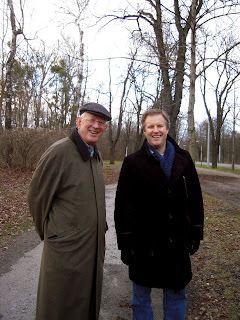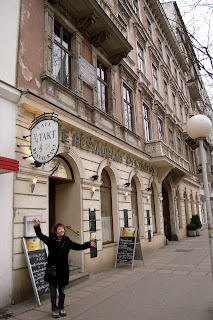Life in Leopoldstadt
Whilst residing in Leopoldstadt last month, we enjoyed Viennese life in another part of the city, the 2nd district. We know from our history and tour books, and from our December tour with Professor Klaus from the Uni Graz, this district, just beyond the city’s “inner ring,” was originally a Jewish neighborhood. Then in 1669, Leopold I, was badgered by many (including his wife) to expel the Jews and give the whole neighborhood (shops, cafes, apartments, everything) to Christians. Thus, the district was named Leopoldstadt. Ironically, in the 19th and early 20th centuries, Leopoldstadt was the primary neighborhood for Jewish refugees fleeing Eastern Europe. Memory stones and plaques memorialize the fate that befell many of those same refugees in the 1930s and ‘40s. Today, the 2nd district continues to be a center of the Jewish community, as well as home for new immigrants and refugees from Eastern Europe, the Middle East, Africa, and Asia. This makes for interesting touring with your eyes, ears, and taste buds. (Let us know if you are ever craving authentic Korean cuisine when you are in Vienna – we can tell you where you need to go.)
One of the hundreds of Memory Path plaques ("Weg der Erinnerung") on the sidewalks all around the 2nd district. We saw this plaque every day because it is right in front of our favorite grocery store, just around the corner from our appartment.

An Augarten yoga practice in the fall. Vrksasana (tree pose) is particularly inspired in such an environment.
Prater is only a five-minute walk from our flat, so Prater, not Augarten, was our park of choice while living in the 2nd district. Semantically, Prater is less of a “park” and more of a “forest” since it covers 23 square miles. The area was originally a royal hunting ground (as was Augarten), but was opened to the public in 1766 (Augarten was opened in 1775). We’ve enjoyed Prater’s stately boulevard and the surrounding oak and chestnut woodlands in late summer, fall, and now winter. By now we shouldn’t be surprised that droves of Viennese of all ages and physical abilities, would be walking and biking, even in very chilly months. Our favorite tour book, Time Out Vienna, states the tree-lined main boulevard, the 2-miile long Hauptalle, “…has been synonymous with a Viennese Sunday stroll since it was opened …” We’ve been part of that tradition through what some call Wien’s “green lung”.

Trav stands outside the Prater History Museum which houses all sorts of fantastic Prater artifacts, maps, photos, etc. Inside, we were especially impressed with documentation of yearly park transformations in the early 1900s. For instance, one year the park was remodeled to look like Venice. The next year, "a journey to Africa" or "the Far East" could be the theme. We were also a little creeped-out by the unfortunate display of "freaks" (bearded lady, lion man, fattest baby, tallest man, pin heads, etc). Oh dear.


This Riesenrad photo was taken after a late-afternoon stroll through the woods last fall.
Although our favorite area of Prater’s 23 square miles is the woodlands, the most famous corner is probably the amusement park (carousels, bumper cars and roller coasters) and of course, the Riesenrad, the giant wheel. The Riesenrad, made famous in the Orson Welles film The Third Man, was completed in 1897 to celebrate Franz Josef’s Golden Jubilee. The 15 wooden gondolas (originally there were 30) are in motion year round. Each gondola can accommodate 20 people, and you can even rent a gondola for a wedding or other special event, or the Prater even caters meals in the cars – remember, regardless of where you are in Wien, food cannot be far away. During a slow and exciting 20 minutes, the giant wheel takes you up 213 feet to take in the city’s view. In 2002 we rode the Riesenrad about one hour after our arrival to town; this year we’ve enjoyed reading about its history in the Prater museum and seeing the giant wheel from the terra firma, but we’ve yet to be carried by the giant!

Relishing a Christmas Eve Prater stroll with true Viennese - our beloved Kupkas, who are Hauptalle regulars. Note Frau Kupka's walking sticks. Such sticks are all the rage in all seasons.


Johann Strauss (the younger) lived just down the street on Prater Strasse, a five-minute walk to both the Prater Hauptalle, and our flat. In Strauss’s spacious 2nd-floor apartment, we marveled at the beautiful grand piano, organ, violin, and stand-up composing desk, all used by Wien’s beloved waltz king. The original manuscript for the Blue Danube Waltz, composed in this house, is also on display! After paying homage to one of Vienna’s favorite sons, we danced downstairs to the ¾ time Café (clever name, eh?) for a scrumptious lunch with musical accompaniment. The unexpected note was the ¾ time Café was not playing Strauss, nor any other Wiener waltz; instead, they were playing ABBA from a boom box.

1-2-3, 1-2-3, 1-2-3 . . .

Karla really wanted to put on the dress but the docent discouraged such behavior.

Yes, this is it! The original Blue Danube score! Everyone hum along now.

They are all here, meine Damen und Herren, waltzes, marches, polkas - even quadrilles!

1 comment:
So, uh...hey Cousin. How have you been? We missed you at the wedding but it's completely understandable, what with you being half a world away and all. Now that we drive through Lincoln en route to Colorado we will just have to stop by and say Guten Tag! I love the blog and it's nice to have some way to keep up now. Talk with you soon I hope.
Cousin Michael
Post a Comment